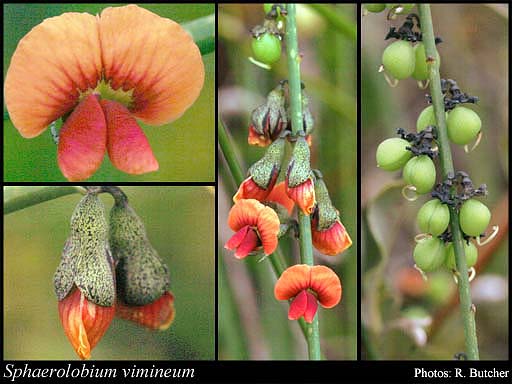- Reference
- K.D.Koenig & Sims, Ann.Bot. 1:509 (1805)
- Conservation Code
- Not threatened
- Naturalised Status
- Native to Western Australia
- Name Status
- Current
Erect or ascending, leafless, slender, multi-stemmed shrub, 0.3-1.2 m high. Fl. orange-yellow-red, Aug to Dec. Black peaty soils, sandy clay, clay. Winter-wet depressions, swamp edges.

Scientific Description
Genus Sphaerolobium. Form erect. Habit shrub, spindly shrub (broom-like). Stems Indumentum glabrous, Pustules or glands absent, Striation (stems ribbed) not striate, Cross section terete, Spiny on any part of plant not spiny. Leaves or phylloclades Presence clearly present, Position alternate, Leaves simple, Leaves or phylloclade continuous with stem continuous with stem, Cross section of leaf or leaflet flat with flat margins, Margins of leaf or leaflet entire, Tuberculate tubercles absent, Pustules or glands absent. Length Leaf length 3-5.6. Width (entire leaves only) Leaf width 0.2-0.3. Scale leaves length mm long NaN (?). Indumentum Presence hairy, Type simple. Stipules Presence apparently absent even from the youngest leaves, Glands with glands (?) or without glands (?), Ribs ribbed (?) or ribless (?). Length Stipule length NaN (?). Bracteoles Presence present and persistent, Indumentum hairy (?) or glabrous (?), Striation striate (?) or not striate (?). Length Bracteole length NaN (?). Pedicel Presence present, Indumentum glabrous. Length Pedicel length 1.5-2. Calyx Pustules or glands absent, Ribs ribless, Enlarged in fruit not accrescent. Length Calyx length 4.5-5.2. Indumentum Presence hairy or glabrous, Type with simple hairs. Corolla Colour patterning multicoloured, Colour (when multicoloured - choose one colour) yellow, red or orange, Colour (when multicoloured - choose a second colour) yellow, red or orange, Petal claws ( the narrow base of the petals present. Length Corolla length 8-9. Indumentum Presence absent. Standard Indumentum glabrous, Auricles not auriculate. Length Standard length 7-7.5. Wings Auricles not auriculate. Length Wing length 4.5-4.8. Keel Auricles not auriculate, Indumentum glabrous, Beak not beaked. Length Keel length 4-4.5. Stamens Number ten. Anthers anther length 0.4-0.5, Position at two different levels (filaments alternately long and short). Filaments Fusion free (or united at the very base). Length Filament length 2.2-3.5. Ovary Placement stipitate. Indumentum Presence glabrous. Style Indumentum glabrous, Bearded ( with a tuft of hairs at apex ) not bearded, Apex terete. Length Style length 7-7.5. Fruit Type dehiscent (a pod or follicle), Constriction not constricted between the seeds, Compression round in cross-section, Placement stipitate, Beak not beaked. Length Fruit length NaN (?). Width Fruit width NaN (?). Indumentum Presence hairy (?) or glabrous (?), Indumentum type with simple hairs (?) or with glandular hairs (?). Flowering time August, September, October, November or December. Distribution Botanical Province South-West, IBRA Bioregion Jarrah Forest, Warren, Esperance or Swan Coastal Plain.
Distribution
- IBRA Regions
- Esperance Plains, Jarrah Forest, Swan Coastal Plain, Warren.
- IBRA Subregions
- Northern Jarrah Forest, Perth, Recherche, Southern Jarrah Forest, Warren.
- IMCRA Regions
- WA South Coast.
- Local Government Areas (LGAs)
- Albany, Augusta Margaret River, Bayswater, Boyup Brook, Canning, Cockburn, Collie, Cranbrook, Denmark, Esperance, Harvey, Kwinana, Manjimup, Mundaring, Murray, Plantagenet, Swan, Waroona.